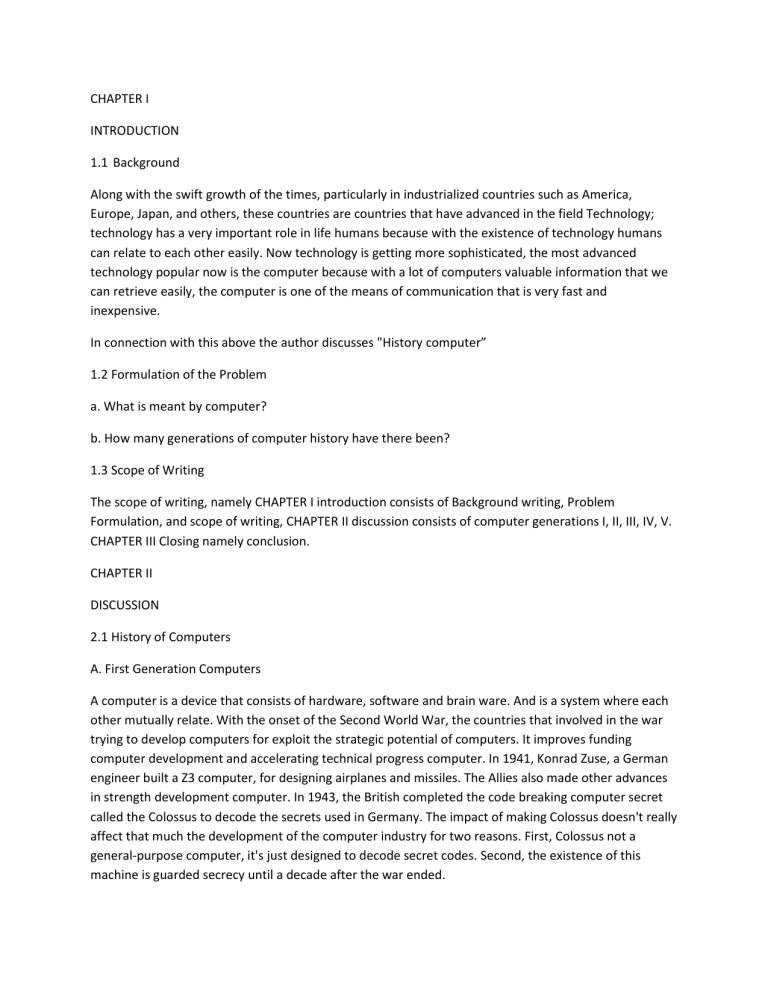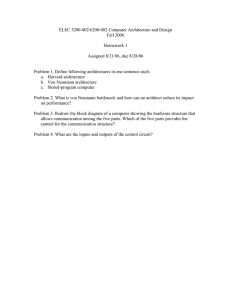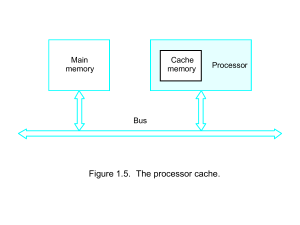
CHAPTER I INTRODUCTION 1.1 Background Along with the swift growth of the times, particularly in industrialized countries such as America, Europe, Japan, and others, these countries are countries that have advanced in the field Technology; technology has a very important role in life humans because with the existence of technology humans can relate to each other easily. Now technology is getting more sophisticated, the most advanced technology popular now is the computer because with a lot of computers valuable information that we can retrieve easily, the computer is one of the means of communication that is very fast and inexpensive. In connection with this above the author discusses "History computer” 1.2 Formulation of the Problem a. What is meant by computer? b. How many generations of computer history have there been? 1.3 Scope of Writing The scope of writing, namely CHAPTER I introduction consists of Background writing, Problem Formulation, and scope of writing, CHAPTER II discussion consists of computer generations I, II, III, IV, V. CHAPTER III Closing namely conclusion. CHAPTER II DISCUSSION 2.1 History of Computers A. First Generation Computers A computer is a device that consists of hardware, software and brain ware. And is a system where each other mutually relate. With the onset of the Second World War, the countries that involved in the war trying to develop computers for exploit the strategic potential of computers. It improves funding computer development and accelerating technical progress computer. In 1941, Konrad Zuse, a German engineer built a Z3 computer, for designing airplanes and missiles. The Allies also made other advances in strength development computer. In 1943, the British completed the code breaking computer secret called the Colossus to decode the secrets used in Germany. The impact of making Colossus doesn't really affect that much the development of the computer industry for two reasons. First, Colossus not a general-purpose computer, it's just designed to decode secret codes. Second, the existence of this machine is guarded secrecy until a decade after the war ended. The efforts made by the Americans at that time produced something another advance. Howard H. Aiken (1900-1973), a Harvard engineer who worked with IBM, successfully producing electronic calculators for the US Navy. The calculator is half the length of a football field and has cable span of 500 miles. The Harvard-IBM Automatic Sequence the Controlled Calculator, or Mark I, is an electronic relay computer. He uses electromagnetic signals to drive mechanical components. The machine operates slowly (it takes 3-5 seconds for each calculation) and inflexibility (calculation order cannot be changed). Calculator it can perform basic arithmetic calculations and more equations complex. Another computer development at this time was Electronic Numerical Integrator and Computer (ENIAC), which was created by collaboration between governments United States and the University of Pennsylvania. Consists of 18,000 tubes vacuum, 70,000 resistors, and 5 million solder points, the computer is a very large machine that consumes 160kW of power. this computer designed by John Presper Eckert (1919-1995) and John W. Mauchly (1907- 1980), ENIAC is a versatile computer (general purpose computer) works 1000 times faster than the Mark I. In the mid-1940s, John von Neumann (1903-1957) joined University of Pennsylvania team in an effort to build a computer design concept which for the next 40 years is still used in engineering computer. Von Neumann designed the Electronic Discrete Variable Automatic Computer(EDVAC) in 1945 with a memory to hold either programs or data. This technique allows the computer to stop at one point and then resume his work again. Master key von Neumann architecture is the central processing unit (CPU), which allows all computer functions to be coordinated through one single source. In 1951, the UNIVAC I (Universal Automatic Computer I) made by Remington Rand, became the first commercial computer that utilizing the von Neumann architectural model. Good Census Bureau The United States and General Electric own UNIVAC. One result what impresses UNIVAC is its success in predicted Dwilight D. Eisenhower's victory in the presidential election 1952. B. Second Generation Computers In 1948, the invention of the transistor greatly influenced development computer. The transistor replaced the vacuum tube in televisions, radios and computers. As a result, the size of the electric machines was reduced drastically. Start transistors used in computers starting in 1956. Another invention in the form the development of magnetic-core memory helped the development of computers smaller, faster, more reliable, and more second generation energy efficient compared to its predecessors. The first machine to utilize this new technology is supercomputers. IBM makes a supercomputer named Stretch, and Sprery-Rand built a computer called LARC. These computers, which were developed for the atomic energy laboratory, can handle large amounts of data, a capability much needed by atomic researcher. These machines are very expensive and tend to be too complex to operate business computing needs, thereby limiting its popularity. There are only two LARCs installed and used: one at Lawrence Radiation Labs in Livermore, California, and others at US Navy Research and Development Center in Washington D.C. The second generation of computers replaced machine language with assembly language. Assembly language is a language that uses abbreviations to replace the binary code. In the early 1960s, a successful second generation of computers began to appear in business, in universities, and in government. Computers this second generation is a computer that fully uses transistor. They also have associable components with computers today: printers, disk storage, memory, operating system and programs. One of the important examples of computers at this time is the IBM 1401 which is widely accepted in the industry. in 1965, almost all big businesses use second generation computers for processing financial information. C. Third Generation Computers Although the transistor is in many ways superior to the vacuum tube, however transistors generate a considerable amount of heat, which can be potentially damaging computer internal parts. Quartz stone (quartz rock) removes this problem. Jack Kilby, an engineer at Texas Instruments, developed integrated circuit (IC: integrated circuit) in 1958. IC combines three electronic components in a small silicon disc made of quartz sand. Scientists later managed to include more components onto a single chip called a semiconductor. As a result, computers have become smaller and smaller as their components can compacted in chips. Other third generation computer advances are the use of an operating system (operating system) that allows the machine to run many different programs concurrently with a the main program that monitors and coordinates the computer's memory. D. Fourth Generation Computers After IC, the development goal became clearer which is shrinking circuit sizes and electrical components. Large Scale Integration (LSI) an fit hundreds of components on a single chip. In the 1980s, Very Large Scale Integration (VLSI) contains thousands of components on a chip single. Ultra-Large Scale Integration (ULSI) increases that number to millions. The ability to install so many components in one the coin, which was half the size of a coin, pushed prices down and computer size. It also increases the working power, efficiency and reliability of computers. The Intel 4004 chip which was made in 1971 brought progress to the IC by putting all the components of a computer (central processing units, memory, and input/output controls) on a single chip very small. Previously, IC was made to do a certain task Specific. Now, a microprocessor can be produced and then programmed to meet all the desired needs. Not long then, every household device like microwave oven, television, and Cars with electronic fuel injection is equipped with a microprocessor. Such developments made it possible for ordinary people to using a regular computer. Computers are no longer the dominance of large companies or government agencies. In the mid 1970's, computer assemblers offer their computer products to the general public. These computers, called minicomputers, are sold in software packages easy-to-use software. Most software Popular at the time were word processing and spreadsheet programs. In the beginning In the 1980s, video games such as the Atari 2600 attracted consumer attention more sophisticated and programmable home computers. In 1981, IBM introduced the use of Personal Computer (PC) for home, office and school use. Number of PCs used jumped from 2 million units in 1981 to 5.5 million units in 1982. Ten years later, 65 million PCs are in use. The computer continues evolution towards a smaller size, from the computer that is above table (desktop computer) into a computer that can be put in a bag (laptop), or even a handheld computer (palmtop). E. Fifth Generation Computers Defining fifth generation computers has become quite difficult because this stage is still very young. An imaginative example of fifth generation computers is the fictional HAL9000 computer from Arthur C. Clarke's novel 2001: Space Odyssey. HAL displays all the desired functions of a fifth generation computers. With artificial intelligence (artificial intelligence), HAL can have reason enough to carry out conversations with humans, use visual input, and learn from their own experiences. Although perhaps the realization of HAL9000 is still far from reality, there are many its functions have been realized. Multiple computers can receive instructions verbally and are able to imitate human reasoning. Ability to translate foreign languages also becomes possible. This facility is visible simple. But the facility became much more complicated than expected when programmers realize that human understanding really depends on context and meaning rather than translating words literally direct. Many advances in the field of computer design and technology are accelerating made the fifth generation of computers possible. Two engineering advances most notably parallel processing capabilities, which will supersede the von Neumann model. The von Neumann model will be replaced by a system that able to coordinate multiple CPUs to work synchronously. Another advancement is superconducting technology which allows flow electricity without any obstacles, which can later accelerate the speed information. CHAPTER III CLOSING 3.1 CONCLUSION From the description above, the writer can conclude that the computer is a device consisting of hardware that can be physically touched (hardware), software, a device that cannot be touched manually physical (software), and Brain ware, namely a computer user or user. In this case, there are several generations of computer history, namely as follows: A. The first generation of computers: Electronic Numerical Integrator and Computer (ENIAC), which was created by cooperation between governments United States and the University of Pennsylvania B. Second generation computers: the invention of the transistor greatly influenced computer development. Transistors replaced vacuum tubes in televisions, radios and computers. As a result, the size of the electric machines is reduced drastic. Transistors began to be used in computers starting in 1956. Another discovery in the form of the development of magnetic-core memory assisted in the development of smaller, more powerful, second-generation computers faster, more reliable, and more energy efficient than predecessor. The first machine to take advantage of this new technology is a supercomputer. IBM makes a supercomputer called Stretch, and Sprery-Rand built a computer called LARC. These computers, which were developed for the atomic energy laboratory, can handle large amounts of data, a very capability needed by atomic researchers. Such machines are very expensive and inclined too complex for business computing needs, limiting it his popularity. Only two LARCs have ever been installed and used: one at Lawrence Radiation Labs in Livermore, California, and the other at the US Navy Research and Development Center in Washington D.C. The second generation of computers replaced machine language with assembly language. Assembly language is a language that use abbreviations to replace the binary code. C. Third generation computers: computers are getting smaller because components can be compacted on the chip. Computer progress Another third generation is the use of operating systems (operating system) that allows the machine to run various programs simultaneously with a different main program monitor and coordinate computer memory. D. Fourth Generation Computers: Large Scale Integration (LSI) can load hundreds of components on a chip. In the 1980s, Very Large Scale Integration (VLSI) contains thousands of components on a single chip. Ultra-Large Scale Integration (ULSI) increases that number to millions. The ability to install so many components in one the coin, which was half the size of a coin, pushed prices down and computer size. It also improves workability, efficiency and reliability computer. The Intel 4004 chip which was made in 1971 brought progress on IC by putting all the components of a computer (central processing unit, memory, and input/output control) in a chip that very small. Previously, IC was made to do a task certain specific. Now, a microprocessor can be manufactured and then programmed to meet all that need wanted. E. Fifth Generation Computer: fictional computer HAL9000 from the novel by Arthur C. Clarke titled 2001: Space Odyssey. HAL displays all the desired functions of a fifth generation computer. With artificial intelligence (artificial intelligence), HAL can be enough have reason to do conversation with humans, use visual input, and learn from their own experiences. Although the realization of HAL9000 may still be far from reality, many of its functions have been realized. A number of computers can receive instructions verbally and are able to imitate reasoning man. The ability to translate foreign languages also becomes Possible. This facility looks simple. But the facility becomes much more complicated than expected when programmers realize that Human understanding is very dependent on context and understanding rather than just translating the words directly.



